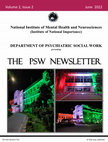Talks by Dr. Sojan Antony
Increase in the percentage of elderly population in India poses challenges to existing health sys... more Increase in the percentage of elderly population in India poses challenges to existing health systems and opens opportunities for health care policymakers and professionals. Affordable quality health care is the right of the elderly population. Current health care system needs to invest resources to cater this requirement and to establish a comprehensive health system for elderly. Economic and social marginalization of the elderly population due to the cognitive decline and noncommunicable diseases demand scientific planning to facilitate comprehensive geriatric care that is affordable and accessible particularly to indigent senior citizens in India. Further, the primary health care system has to be prepared to provide preventive, curative and rehabilitative services at community level.
Papers by Dr. Sojan Antony

Indian Journal of Psychological Medicine, Feb 1, 2023
Background: Family members, peers, and significant others are part of a college student’s social ... more Background: Family members, peers, and significant others are part of a college student’s social network. This cross-sectional study aimed to Assess substance use prevalence and patterns among college students, Compare the social network characteristics of substance users (SUs) and non-users (NUs), and Explore the association of social factors with substance use. Methods: The study involved 902 students from 11 Government and aided private degree colleges. Demographic and clinical data sheet, ASSIST, and Social Network Questionnaire were used to collect the data. Results: Prevalence of substance use was 26.9% and higher among males (21.5%). Alcohol (20%) and tobacco (15.5%) were the commonly used substances. SUs’ network was composed of unmarried persons (p<0.002), male members (p<0.001), and friends (p<0.001) with substance use. In contrast, the NUs’ network comprised parents (p<0.016) and siblings (p<0.001). NUs had a higher number of influential members in the network, whereas SUs had more closeness with members and received higher financial support (p<0.001). Participant’s age (OR 1.27), family history of substance use (OR 2.46), parents’ occupation (Business: OR 1.79, being employee in the government or industry: OR 1.76),and having three substance-using members in the network (OR .211) were found to be risk factors. Conclusion: Social network has an association with substance use among college students. Social-network-based interventions may benefit them.

Indian Journal of Psychiatry
Background: Causes of substance use are multifactorial. Factors such as personality, psychologica... more Background: Causes of substance use are multifactorial. Factors such as personality, psychological distress, and the person’s social ties contribute to the understanding of substance use problems of college students. Aim: The current study aimed to investigate the association between personality traits and psychological distress with ego-centric social networks of substance-using and non-using college students. Method: This cross-sectional descriptive study involved 902 undergraduate students from the government (n = 2) and government-aided (n = 9) colleges. The socio-demographic data sheet, Big Five Personality Inventory, Depression Anxiety and Stress Scale, and the semi-structured Ego-centric Social Network Questionnaire were used to collect data. Results: Of 902 participants, 26.9% of participants used substances. The mean score of anxiety (P < 0.002) and depression (P < 0.002) was significantly higher among the substance users compared with non-users. Agreeableness (P <...
Archives of Mental Health

Indian Journal of Psychological Medicine
Background: Family members, peers, and significant others are part of a college student’s social ... more Background: Family members, peers, and significant others are part of a college student’s social network. This cross-sectional study aimed to Assess substance use prevalence and patterns among college students, Compare the social network characteristics of substance users (SUs) and non-users (NUs), and Explore the association of social factors with substance use. Methods: The study involved 902 students from 11 Government and aided private degree colleges. Demographic and clinical data sheet, ASSIST, and Social Network Questionnaire were used to collect the data. Results: Prevalence of substance use was 26.9% and higher among males (21.5%). Alcohol (20%) and tobacco (15.5%) were the commonly used substances. SUs’ network was composed of unmarried persons (p<0.002), male members (p<0.001), and friends (p<0.001) with substance use. In contrast, the NUs’ network comprised parents (p<0.016) and siblings (p<0.001). NUs had a higher number of influential members in the netw...
Alzheimer's & Dementia
Journal of the Indian Academy of Geriatrics

The PSW Newsletter, 2022
Social Work interventions in mental health care settings are generally known as Psychiatric Socia... more Social Work interventions in mental health care settings are generally known as Psychiatric Social Work Interventions. Now, these interventions are customized to cater to the biopsycho-social needs of individuals and their families. Similarly, our contributions are noteworthy in promoting the rights of people living with mental disabilities, advocacy, and improving their overall quality of life. We all are well aware of homelessness and institutionalization as a consequence of mental illness. Our passion for community-based rehabilitation and our } [ sincere effort in exploring options for building resources for families and communities have become models in our country. I am happy to inform you all about the growing human resource development activities by NIMHANS in mental health and allied disciplines. Currently, nearly 90 trainees are pursuing their Master of Philosophy (M.Phil) in Psychiatric Social Work and nearly 60 Ph.D. scholars are pursuing their Ph.Ds. Each year at least 10 of our scholars are completing their Ph.D. and joining leading academic and research institutions both in India and abroad. Our alumni members are thought leaders in mental health. In this context, let us introspect further, on how we can empower our budding professionals. Many senior social work professionals are advocating the importance of the case management approach as a comprehensive social work intervention for the welfare of persons living with mental health and neurological disorders. Social case management services are crucial in promoting the recovery and remission of the illness. NIMHANS has been leading at the forefront in shaping these interventions in the past five decades. Now, the time has come, for us to be more proactive in developing indigenous social care models, which will be highly suitable for our population. These models have to be designed for people who face various psychosocial challenges in different sections of society. In addition to that, we have a major duty in the treatment team to orient our fellow professionals regarding the implications of the personin-situation theory. As we have observed, social support plays a key role in seeking care and in ensuring continuity of care. Our focus has to be on skill-building in these core areas. The theories and pragmatic approaches of our sister disciplines would enhance the quality of our individual, family, and group-based interventions. We also need to be more aware of social transitions and the implications of rapid changes secondary to demographic and geopolitical revolutions. In this regard, let our Newsletter initiative throw more light on key practice scenarios. I congratulate the editorial team and all contributors for publishing this edition of the PSW Newsletter.
The PSW Newsletter, 2022
College mental health-Early identification and treatment, teacher training in counselling skills,... more College mental health-Early identification and treatment, teacher training in counselling skills, stress management, instilling life skills in students,

Need for more old age homes are increasing day by day. Living in an institution demands specific ... more Need for more old age homes are increasing day by day. Living in an institution demands specific adjustment skills to cope up with the problems. This study aims to develop and test the feasibility of group based adaptation skills training programme for the inmates of old age homes to ensure their wellbeing. The major objectives 1) to study the psychosocial needs and concerns of senior citizens living in old age homes, 2) to develop a group based training programme for inmates of old age homes for enhancing their adaptation skills 3) to test the feasibility of the proposed programme in reducing adaptation difficulty, depression, anxiety and improving the wellbeing. The hypotheses of the study are group based adaptation skill training programme will reduce adaptation difficulty, depression and anxiety and improve well-being among elderly. Quasi-experimental research design will be used in this study. Simple random sampling method will be used in this study. Senior Citizens who live in...
Journal of Geriatric Mental Health

International journal of innovative research and development, 2016
This paper aims to find the coping strategies used by cancer patients to deal with physical and p... more This paper aims to find the coping strategies used by cancer patients to deal with physical and psychological problems of chemotherapy. 30 participants above the age of 25, who were undergoing chemotherapy were chosen by purposive sampling method for the study. The instruments administered included socio-demographic and clinical schedule, Becks Depression Inventory-II, Becks Anxiety Inventory, a self-developed tool to assess physical problems and a semi structured interview schedule to assess the physical problems. The mean age of the participants were 55.33 years. Majority of the participants 63.33%(19) were females, 76.7%(23) were married. The most common cancer, which 33.33% of the participants had was breast cancer and 33.33% of the participants suffered from stage II cancer. Only 30% of the participants had prevalence of depression, while 26.67% of the participants had prevalence of anxiety. There was no significant difference in the level of anxiety and depression between the ...
Journal of Psychosocial Rehabilitation and Mental Health, 2022











Uploads
Talks by Dr. Sojan Antony
Papers by Dr. Sojan Antony